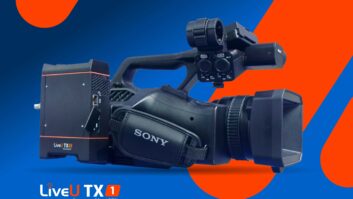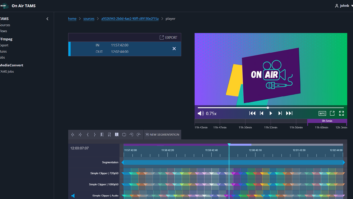
Last January, BBC, ITV and Channel 4 together with Sky, Channel 5, S4C and UKTV agreed the UK’s first common file format, structure and wrapper to enable TV programme delivery by digital file.
Emmerdale became the first major UK production to adopt the new international AS-11 standard for HD delivery in October and the Sunset & Vine-produced America’s Cup programming for C4 was the first to use its metadata application, which is wrapped into the programme file.
Trials will build throughout 2013 including those by ITV for Coronation Street and by Endemol for C4’s Deal or No Deal. With technical guidelines based on MPEG-4 for live production now on release, Channel 4’s new year racing coverage, produced by IMG Sports Media and supplied by NEP Visions, will be among the first to action it.
Post production facilities are also piloting DPP deliverables with broadcasters in the next few months. “We are assessing various systems to enable us to achieve AS-11 delivery including automated QC/FPA analysis and metadata insertion for final delivery,” says Envy Senior Engineer Adam Davies.
International acceptance
The DPP is also talking with US studios about adopting a version of the spec. Talks are advanced, not least because US body Advanced Media Workflow Association (AMWA) worked with the DPP to create AS-11.
“There’s already quite a demand from a couple of the studios to deliver by file for cost reasons,” explains one of the DPP’s architects, Kevin Burrows (pictured), CTO Broadcast and Distribution, Channel 4 and chair of the DPP Technical Standards working group.
Broadcasters overseas have pricked up their ears. “We’ve had enquires from France and Germany and the EBU who are interested in adapting what we are doing,” he says. “If a company is already standardised on XDCAM there’s a cost and time to change implication in moving away from that. Some have already taken the leap in quality, but it’s the standard way we have treated metadata which is a significant step ahead of the game.”
The final Master for delivery in the UK is currently predominantly on tape, and HDCAM SR is the format of choice for HD commissions from major UK broadcasters. But the DPP’s principal backers – ITV, BBC and Channel 4 – have agreed that delivery on file will be preferred by 2014.
“We cannot mandate 100% [the BBC charter wouldn’t allow it for one thing] but we expect 98% of companies to be able to do so,” says Burrows.
To create DPP-compliant files all the producer or post house require is technology suitable for generating AVC Intra 100 Mbs files, which the latest models of Avid and FCP (launched in December) will do, along with transcoders and the means to transport them. The latter is considered a minor hitch, hence the delay until 2014.
Signiant and Aspera
Broadcasters have adopted accelerated, file delivery over IP networks to a significant extent over the past five years, where such technology is cheaper than tape traffic, and also faster and more secure than methods such as FTP.
Solutions from Signiant and Aspera are, however, not yet pervasive outside of broadcasters, some distributors and the larger production and post companies, so in the near term the most common form of file-based delivery is likely to be removable drive.
“While this may make commercial and logistical sense for production companies, it is less effective for broadcasters,” says Burrows. “They would prefer to receive files over an IP network so that they can avoid manually copying files, and make use of fully automated workflows starting at the entry point into the broadcaster’s architecture.”
Realistically, broadcasters may need to share infrastructure based on technologies such as Signiant and Aspera to enable companies to transfer completed programmes to them.
“It is reasonable to expect broadcasters to take the lead – with key suppliers – in defining the most effective and pragmatic means of file delivery over the next year or two regardless of the volume of content delivered,” the DPP states.
Burrows adds: “We are happy to take in any mechanism – removable hard drives or LTO or leased lines. But for some producers delivering large volumes or daily programming it make sense to use Signiant and Aspera – and there are various licensing models for those. We are not going to mandate one or another – it is whatever fits with a broadcaster.”
Live production
The live guidelines, which were issued in October, cover contribution by satellite links, fibre or microwave links as well as recommended practices for the delivery of stereo and multichannel audio.
“Historically, live production has been driven by Sky and the BBC, mostly based on MPEG-2 using whatever kit was available at the time and using a mix of high and some lower quality bitrates,” explains Burrows. “Given that there are only a handful of major live sports production companies in the UK, the DPP felt we should and could agree guidelines.
“This is standardised on MPEG-4 to try and drive old kit out. We recognise that in some areas this is hard – with something aired at 3am it may be harder to justify high bitrates than in primetime – but the timing was right for a guideline that people will follow. If a broadcaster sees fit to change it for commercial reasons that’s at their discretion.”
Aside from ramping up the pilots, the DPP will next address loudness. “We want to get a revised spec in place for Q1,” says Burrows. “We are complying with EBU R128 loudness metering but we want to issue guidelines of usage for whether a show is live or recorded or within genre, for example, whether metering should differ between a pop or classical music concert. The other thing is that EBU R128 is a measurement designed for long form, so how does short form content fit that?”
The DPP’s speed and relative equanimity with which it has cracked the file-barrier is arguably the envy of other countries. Its official documentation is called ‘The Bloodless Revolution’.
Explains Burrows: “A lot of content in the UK emanates from small production companies where there is not a lot of dedicated expertise so the over-arching idea was to give them guidance on the whole end to end workflow from acquisition through post to delivery. In the longer term this makes it easier for everyone so we’re not battling lots of different standards and broadcasters don’t, for example, receive a file from one production company that won’t play out on their server. Files will never be as easy as tape but by trying to standardise we are trying to avoid the interoperability issues which plague us all.”
From MXF to DPP
By Bruce Devlin, chief technology officer at AmberFin and co-author of the original MXF specification
The original purpose of the group of individuals and organisations that created the MXF specification was to make a file format for the media industry that addressed the needs of the industry in a way that would provide a work-horse for years to come without being the intellectual property of a single vendor. Years of work took place and the number of contributors dwindled from hundreds in the early days contributing requirements and great ideas to the pool; down to a mere 10-20 dedicated vendors at the end of the process, refining and developing the standard until it reached its goals.
At the end of 2004, SMPTE published the MXF standard, but no-one spotted that all the end users had gone back to their day jobs at the time of publication and the first batch of product was launched by the vendor community using the MXF toolbox in a way that favoured that particular vendor. No one is to blame for this – it is a natural consequence of trying to do something difficult in an open forum. Over the next few years, the MXF standard started to lose some of its appeal as interoperability problems prevented complex systems from ‘just working’.
Some people within AMWA pointed out that MXF would be better if we worked out what media business problem was being solved with the MXF toolbox. These people worked away with forward thinking members of the end user community and a range of application specification were created. The application might be for direct-server playout, or versioning or interchange of mezzanines or exchange of advert metadata. These were (and still are) business problems with a technical solution called MXF. Not unsurprisingly, these business problems were the same ones that were first put forward a decade ago when MXF was being designed.
The Digital Production Partnership (DPP) is perhaps the first of these Application Specifications to receive national scale adoption. It certainly won’t be the last. DPP provides a framework that enables the UK industry to come together and share best practice in digital production and help producers and broadcasters maximise the potential of the digital revolution. Also, it leads the standardisation of technical and metadata requirements within the UK, helping to ensure digital video content can be easily and cost-effectively distributed to audiences via multiple platforms.
A leading technology contributor to the DPP initiative, AmberFin is the first vendor to introduce a DPP specific media file transcoder and ingest workstation. Designated iCR-100-DPP (transcoder) and iCR-300-DPP (media ingest workstation), these new products reflect AmberFin’s aim of addressing the broadest range of media organisations with enterprise level solutions that are designed to meet their specific business needs. In the UK, these products are available through AmberFin’s channel partner ATG Broadcast.







